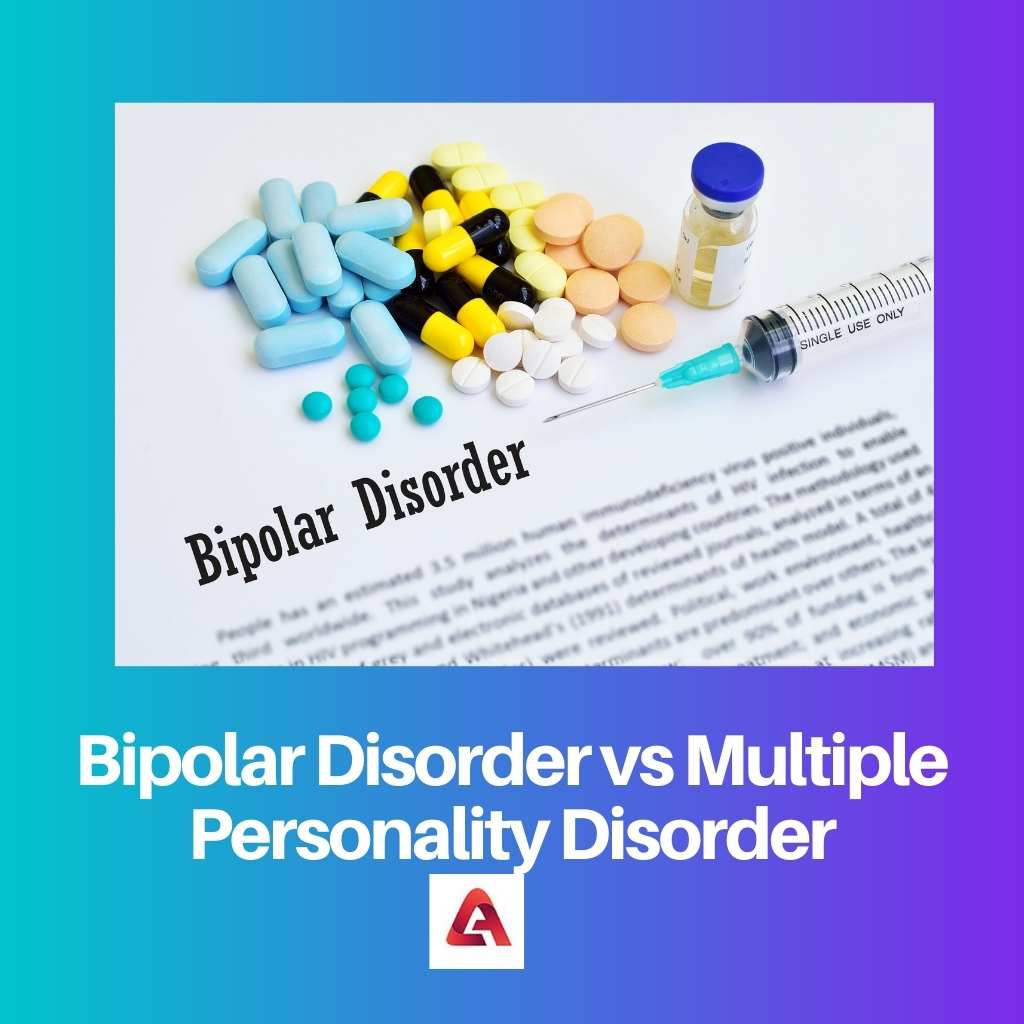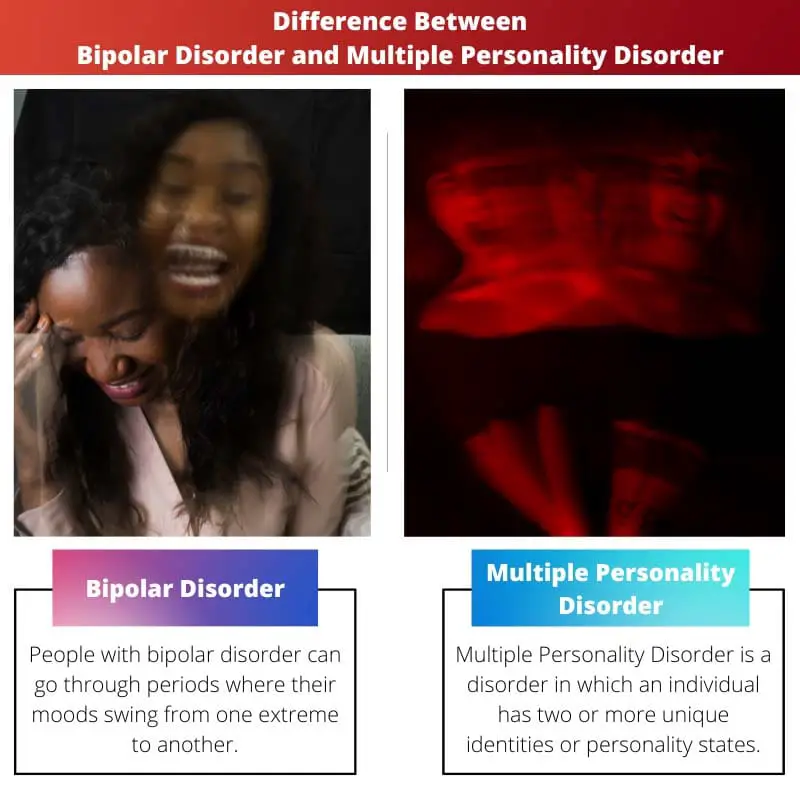The difference between Bipolar Disorder and Multiple Personality Disorder is that when someone has Bipolar Disorder, they have one personality that swings from manic to depressed.
When someone has Multiple Personality Disorder, they have many different characteristics that control their behavior. Dissociative Identity Disorder (DID) is another name for Multiple Personality Disorder.
Key Takeaways
- Extreme mood swings between mania and depression characterize bipolar disorder. In contrast, multiple personality disorder, also known as dissociative identity disorder, involves the presence of two or more distinct identities within a person.
- Bipolar disorder is primarily a mood disorder, while multiple personality disorder is a dissociative disorder.
- Treatment for bipolar disorder includes mood stabilizers and therapy, whereas treatment for multiple personality disorder involves integrating separate identities.
Bipolar Disorder vs Multiple Personality Disorder
Bipolar disorder is a mental health condition characterized by extreme mood swings including emotional highs (mania) and lows (depression). Multiple personality disorder, now known as Dissociative Identity Disorder, involves the presence of two or more distinct identities or personality states within the same individual.

People with bipolar disorder can go through periods where their moods swing from one extreme to another. These are known as manic (or hypomanic) and depressive episodes.
Episodes of extreme air can last for several weeks or even longer. They last for about a week for most people with bipolar disorder.
Multiple Personality Disorder is a disorder in which an individual has two or more unique identities or personality states.
Each personality state in those with the disorder may be experienced as a distinct history, self-image, and identity. MPD is very rare.
The exact cause of Multiple Personality Disorder isn’t known. People with MPD may switch from one personality state to another without warning, either consciously or unconsciously.
Comparison Table
| Parameters of comparison | Bipolar Disorder | Multiple Personality Disorder |
|---|---|---|
| Causes | Chemical imbalances in the brain and stressful life experiences can produce Bipolar Disorder symptoms. | Relationship interactions may trigger multiple personality disorders. |
| Characteristics | Bipolar illness is not associated with issues of self-identity. | Multiple personality disorder is characterized by problems with self-identity, which is divided into various identities. |
| Depression | Depression is one of the bipolar disorder’s alternating states. | Multiple personality disorder patients do not appear to be depressed, and their energy levels are typical. |
| Gender | Males are diagnosed with bipolar disorder more frequently than females. | Multiple personality disorder is more common in women than it is in men. |
| Focus | Bipolar disorder, a frequent mental condition among artists, does not appear to impair creativity or focus. | Multiple Personality Disorder affects a person’s capacity to focus and be creative; hence it’s uncommon for an artist to be diagnosed with it. |
| Memory loss | Memory loss is a common symptom of Multiple Personality Disorder. | There is no specific memory loss in people with Bipolar Disorder. |
| Another name | Manic depression was once known as bipolar disorder. | Dissociative Identity Disorder (DID) is a term used to describe multiple personality disorder. |
What is Bipolar Disorder?
Bipolar disorder, also known as manic depression, is a psychiatric illness characterized by mood swings ranging from mania to sadness. It can be hard to diagnose, with symptoms varying from person to person.
Bipolar disorder has two main phases: manic and depressive. Mania is characterized by high energy and activity periods, while depression involves low energy and activity levels.
People experiencing mania may be more likely to engage in risky behaviors. They might feel invincible or have grand ideas about themselves or their abilities.
When people come out of their manic phase, they enter the depressive phase, where they might feel low in mood or even suicidal. They can lose interest in things, become irritable and find it hard to concentrate or make decisions.
Mania is a high or irritable mood that lasts for at least a week. It’s accompanied by high energy levels, racing thoughts, and an increased sex drive.
Depression is the low mood that follows the manic phase and lasts for weeks or months. In some cases, the mood swings between mania and depression are rapid (days).
In others, they can take several months or even years to change.

What is Multiple Personality Disorder?
A person with multiple personality disorder (MPD) is not aware of the other personalities in oneself. Usually, these personalities have their name and age. They may even have a gender different from that of the individual.
The personalities inside the mind are referred to as “Alters” or “Alter Egos.” Alters can be different from each other in attitudes, values, beliefs, likes and dislikes, ways of thinking and viewing the world, and in their relationships with others.
The identities are different in gender, sexual orientation, temperament, behavior patterns, and how they see the world and interpret events.
The identities may or may not be aware of the others. In between the personalities is amnesia; the individual has no memory of their experiences while in another personality state.
Some people with multiple personality disorder can function in everyday life, while others are so impaired they can’t hold down a job or even take care of themselves.
There is no known cause of multiple personality disorder. Experts believe that a combination of psychological, social, and biological factors is involved in MPD development. Psychological factors may include:
- Childhood emotional, physical, or sexual abuse.
- Extreme neglect.
- Emotionally distant parents or caretakers.
- Biological factors such as genetic predisposition to mental illness or a head injury.
The disorder may result from child abuse and trauma, especially in the first five years of life.

Main Differences Between Bipolar Disorder and Multiple Personality Disorder
- Bipolar disorder, a frequent mental condition among artists, does not seem to impair creativity or focus. However, because Multiple Personality Disorder impairs a person’s ability to focus and be creative, few artists are diagnosed with it.
- Bipolar disorder is diagnosed more commonly in males than in women. On the other hand, women are more likely than males to be diagnosed with multiple personality disorder.
- Bipolar Disorder symptoms can be caused by chemical imbalances in the brain and stressful life experiences, whereas many personality disorders might be caused by relational interactions.
- Memory loss is not a symptom of Bipolar Disorder; however, it is a symptom of Multiple Personality Disorder.
- The bipolar disease used to be called manic depression, whereas Dissociative Identity Disorder (DID) is another name for multiple personality disorder.
- Bipolar disorder has alternate states, one of which is depression. On the other hand, multiple personality disorder individuals do not appear to be sad at first and have normal energy levels.

